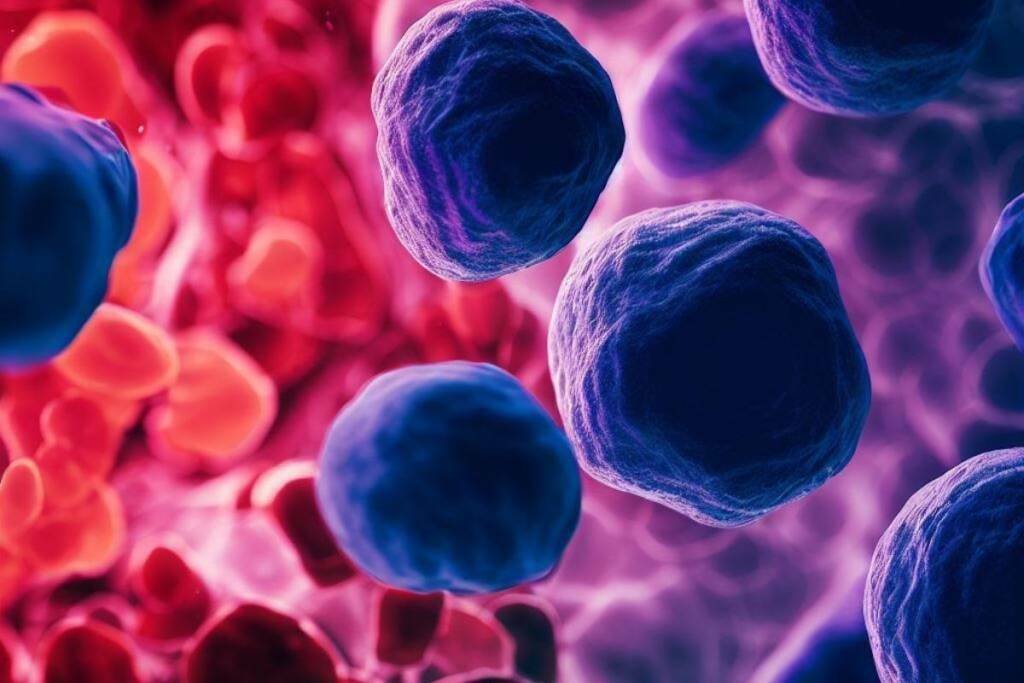Bispecific antibodies in multiple myeloma are a new class of drugs that can target two different antigens at the same time, such as a tumor antigen and a T-cell activator. They have shown promising results in hematologic cancers, especially multiple myeloma, a type of blood cancer that affects plasma cells. Multiple myeloma is often resistant to standard treatments and has a poor prognosis.

In 2022, the drug teclistamab became the first bispecific antibodies in multiple myeloma to be approved by the U.S. Food and Drug Administration (FDA). Teclistamab binds to B-cell maturation antigen (BCMA) on multiple myeloma cells and CD3 on T cells, activating them to kill the cancer cells. The approval was based on the pivotal phase 2 MajesTEC-1 clinical trial, which showed that teclistamab induced an overall response rate (ORR) of 65% and a complete response or better rate of 28% in patients with relapsed or refractory disease who had received at least three prior lines of therapy.
Teclistamab is not the only bispecific antibodies in multiple myeloma. Another drug, talquetamab, also targets BCMA on multiple myeloma cells, but instead of CD3, it binds to GPRC5D (G protein-coupled receptor class C group 5 member D), another protein that is highly expressed on multiple myeloma cells but not on normal cells. By targeting two different antigens, talquetamab may increase the specificity and efficacy of the therapy, while reducing the risk of resistance or escape.

One of the most exciting developments in this field is the combination of teclistamab and talquetamab, which are currently being tested in a phase 1b trial called RedirecTT-1. This is the first trial to ever combine two bispecifics in any human cancer, and the results were presented at the 2023 American Society of Clinical Oncology Annual Meeting (ASCO 2023).
The trial enrolled 93 patients with relapsed/refractory multiple myeloma who had received at least two prior lines of therapy and were refractory to their last line. The patients received escalating doses of both drugs until reaching the recommended Phase II dose (RP2D) of teclistamab at 3.0 mg/kg and talquetamab at 0.8 mg/kg every two weeks. The patients also received step-up dosing to minimize the side effects.
The results were impressive: the ORR was 82.4% at the RP2D, with 38.2% of patients achieving a complete response or better. The responses were durable, with a median duration of response of 10.9 months and a median progression-free survival of 12.4 months. The responses were also consistent across different subgroups of patients, including those with extramedullary or soft tissue plasmacytomas (a difficult-to-treat form of multiple myeloma), those with prior exposure to BCMA-targeted therapies, and those who were triple-class refractory (to proteasome inhibitors, immunomodulatory drugs, and anti-CD38 antibodies).
The safety profile of the combination was manageable and comparable to that of the single agents. The most common side effects were hematologic toxicities, such as anemia, neutropenia, and thrombocytopenia, and infections, which were mostly grade 3 or 4. The most common immune-related side effects were cytokine release syndrome (CRS) and immune effector cell–associated neurotoxicity syndrome (ICANS), which were mostly grade 1 or 2 and treatable with steroids or tocilizumab (an anti-IL-6 antibody). There were six deaths in the study due to infections, but none due to CRS or ICANS.
One of the most striking findings was the high ORR in patients with soft tissue plasmacytomas, which was 85% for the RP2D cohort. Soft tissue plasmacytomas are tumors that arise from plasma cells outside the bone marrow or bones. They are rare, accounting for about 3% to 4% of all cases of multiple myeloma, but they are very aggressive and have a poor prognosis. They are also difficult to treat with conventional therapies, which have low response rates ranging from 5% to 40%. CAR T-cell therapy has shown higher response rates in this subgroup, but they have limited durability and require a complex and costly process of harvesting and engineering the patient’s own T cells.
The combination of teclistamab and talquetamab offers a more convenient and effective option for patients with soft tissue plasmacytomas, as it is an off-the-shelf product that can be given more quickly and easily than CAR T-cell therapy. The responses were also durable, with a median DOR not reached for the RP2D cohort.
The RedirecTT-1 trial is a groundbreaking study that demonstrates the potential of combining two bispecific antibodies in multiple myeloma. It also opens up new possibilities for other combinations of bispecifics in other cancers. Bispecific antibodies in multiple myeloma are emerging as a powerful tool to harness the immune system against cancer, and may offer a more convenient and effective alternative to CAR T-cell therapy.
The key takeaways from this study are that this is another major advance in the treatment of relapsed/refractory myeloma, with efficacy that surpasses what we were used to seeing before. This is an encouraging message for our patients, as we may be able to extend more lives with this approach. This is also a convenient treatment, as after 7 cycles, patients switch to once monthly subcutaneous injections. This is also very manageable from a logistical point of view.
The future of bispecific antibodies in multiple myeloma is bright, as more trials are underway to test different combinations, doses, schedules, and biomarkers. The goal is to optimize the safety and efficacy of this approach, and to identify the best candidates for this treatment. Bispecific antibodies may soon become a standard option for patients with multiple myeloma who have exhausted other therapies or who are looking for a more convenient and less toxic option.
Besides teclistamab and talquetamab, there are other bispecific antibodies in multiple myeloma, targeting different antigens on the cancer cells or the immune cells.
Some of the most promising bispecific antibodies in multiple myeloma in emerging pipeline
- Cevostamab (PF-06863135), which targets BCMA and CD3. It has shown an ORR of 73% in patients with relapsed/refractory disease who had received a median of six prior lines of therapy.
- Regn5458, which targets BCMA and CD3. It has shown an ORR of 60% in patients with relapsed/refractory disease who had received a median of seven prior lines of therapy.
- CC-93269, which targets BCMA and CD3. It has shown an ORR of 89% in patients with relapsed/refractory disease who had received a median of six prior lines of therapy.
- AMG 701, which targets BCMA and CD3. It has shown an ORR of 69% in patients with relapsed/refractory disease who had received a median of six prior lines of therapy.
- HPN217, which targets BCMA and CD3. It has shown an ORR of 73% in patients with relapsed/refractory disease who had received a median of five prior lines of therapy.
- Teclistamab-Daratumumab, which targets BCMA and CD38.
- Talquetamab-Daratumumab, which targets GPRC5D and CD38.
- REGN5459, which targets GPRC5D and CD3. It has shown an ORR of 57% in patients with relapsed/refractory disease who had received a median of six prior lines of therapy.
- CC-99712, which targets GPRC5D and CD3. It is currently being tested in a Phase I trial.
- AMG 424, which targets GPRC5D and CD3. It is currently being tested in a Phase I trial.
- HPN328, which targets FcRH5 (Fc receptor homologue 5) and CD3. It has shown an ORR of 73% in patients with relapsed/refractory disease who had received a median of five prior lines of therapy.
- Elranatamab (PF-06863135), which also targets BCMA and CD3. It has shown an ORR of 83% in patients with relapsed/refractory disease who had received a median of eight prior lines of therapy. Elranatamab is currently being tested in a pivotal Phase II trial called MagnetisMM-3.
These bispecific antibodies in multiple myeloma have different mechanisms of action, pharmacokinetics, dosing schedules, and safety profiles, and may offer different benefits for different subsets of patients. More data are needed to compare their efficacy and toxicity, and to determine the optimal sequencing and combination strategies.
Bispecific antibodies are a new class of drugs that can target two different antigens at the same time, such as a tumor antigen and a T-cell activator.
Future of Bispecific antibodies in multiple myeloma
The future of bispecific antibodies in multiple myeloma looks promising, according to several sources. Bispecific antibodies are a novel immunotherapeutic modality that can bind to both a target on the malignant plasma cells and a target on the cytotoxic immune cells, such as T cells or natural killer cells, and bring them together to destroy the cancer cells123.
Some of the targets that have been explored for bispecific antibodies in multiple myeloma are B-cell maturation antigen (BCMA), G-protein coupled receptor family C group 5 member D (GPRC5D), and Fc receptor homologue 5 (FcRH5)13. Early-phase clinical trials have shown that bispecific antibodies targeting these antigens have a favorable safety profile, with mainly low-grade cytokine release syndrome, cytopenias, and infections, and a high efficacy, with response rates ranging from 61% to 83% and many deep responses in patients who are refractory to multiple lines of therapy134. However, the durability of these responses is still to be established.
FAQs
What are bispecific antibodies, and how do they work in multiple myeloma?
Bispecific antibodies are a class of drugs that target two different antigens simultaneously. In multiple myeloma, they bind to specific proteins on cancer cells and immune cells, activating the immune system to attack the cancer.
Which bispecific antibodies are approved for multiple myeloma?
Teclistamab and talquetamab are approved bispecific antibodies for multiple myeloma. Teclistamab targets BCMA and CD3, while talquetamab targets BCMA and GPRC5D.
What is the significance of teclistamab and talquetamab?
Teclistamab and talquetamab have shown impressive results in clinical trials, especially in patients with refractory disease and soft tissue plasmacytomas. They offer a convenient and effective alternative to traditional therapies.
What are the side effects of bispecific antibodies in multiple myeloma treatment?
Common side effects include low-grade hematologic toxicities, such as anemia and neutropenia. Some patients may experience immune-related reactions like cytokine release syndrome (CRS) and immune effector cell–associated neurotoxicity syndrome (ICANS).


































